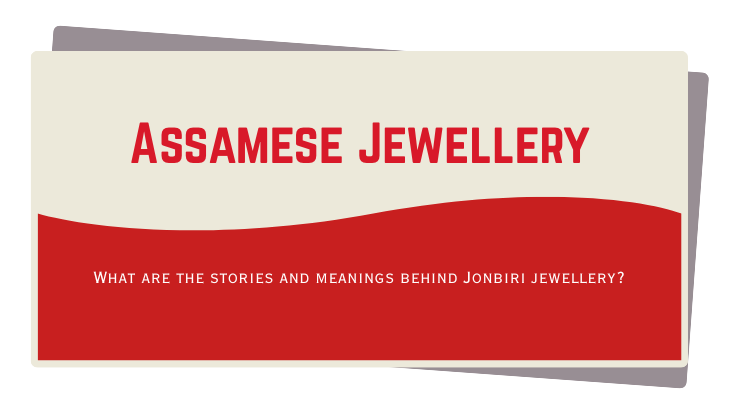What are the stories and meanings behind Jonbiri jewellery?
Blog post description.
ASSAMESE TRADITIONAL JEWELLERY
Kasturi Gogoi


Jonbiri is one of the most iconic traditional ornaments in Assamese culture, known for its elegant crescent moon design and timeless charm. The word “Jonbiri” translates to “moon-shaped ornament,” symbolizing purity, grace, and divine femininity. Rooted in Assam’s rich heritage, it traces its origins to ancient royal jewellery worn by queens and noblewomen during the Ahom dynasty. Handcrafted in gold or silver, often detailed with red and black enamel work, Jonbiri reflects the region’s craftsmanship and artistic depth. Beyond its aesthetic beauty, it carries cultural symbolism tied to the moon, love, and good fortune. Today, Jonbiri remains a beloved accessory during Bihu festivals, weddings, and dance performances, and continues to inspire modern jewellers who reinterpret it for contemporary styles. This graceful ornament beautifully bridges Assam’s past and present, celebrating womanhood and tradition through its design and meaning.
Jonbiri Jewellery: A Symbol of Assamese Grace and Heritage
Introduction
Jonbiri is one of Assam’s most treasured traditional ornaments, worn proudly by Assamese women during festivals, weddings, and cultural events. Its delicate crescent moon design makes it instantly recognizable, and its presence in Bihu celebrations adds to the festive charm. Beyond its visual appeal, Jonbiri represents the deep cultural roots, artistry, and symbolism that define Assamese heritage.
Origin and History of Jonbiri Jewellery
The history of Jonbiri dates back centuries, to the royal courts of the Ahom dynasty, where jewellery symbolized both beauty and status. Goldsmiths, known locally as sonars, crafted intricate ornaments inspired by nature and celestial bodies. The crescent moon became a favored motif, reflecting harmony between human life and the universe. Over time, Jonbiri evolved from royal adornment to a symbol of Assamese identity, blending artistic design with cultural beliefs.
The Meaning Behind Jonbiri
The name “Jonbiri” comes from two Assamese words — Jon, meaning moon, and biri, meaning shape or curve.
The crescent moon represents femininity, serenity, and completeness.
It symbolizes purity and emotional balance — qualities often associated with the moon and womanhood.
In Assamese culture, Jonbiri embodies divine energy and inner radiance, reminding the wearer of the harmony between beauty and spirit.
Design and Craftsmanship
Jonbiri jewellery is a true example of Assamese artistry and precision.
Traditionally made in gold or silver, Jonbiri often features mina work — a form of enamel detailing in red and black.
The pendant takes the shape of a half-moon with delicate engravings, hanging beads, or small motifs inspired by nature.
Every piece is handcrafted by skilled artisans, many of whom have inherited the craft through generations, preserving Assam’s rich jewellery-making traditions.
Folklore and Cultural Stories
Jonbiri carries more than ornamental value — it holds a place in Assamese folklore and song.
Many believe Jonbiri brings luck and charm to the wearer.
It’s often linked to the moon goddess, symbolizing peace, love, and radiance.
Traditional Bihu geet (folk songs) celebrate Jonbiri as a symbol of affection and admiration, often describing it as a gift from a lover or a sign of feminine beauty.
Occasions Where Jonbiri is Worn
Jonbiri remains central to Assamese cultural attire and festive fashion. It’s commonly worn during:
Bihu festivals: especially by women performing the traditional Bihu dance.
Weddings: as part of the bridal jewellery set.
Cultural ceremonies: such as Sattriya Nritya or regional festivities.
Festive dressing: among women showcasing Assamese pride and identity.
Modern Adaptations
While Jonbiri’s roots lie in tradition, its charm continues in modern fashion.
Jewellers now create lightweight and imitation Jonbiri pieces for daily or casual wear.
Contemporary designers blend Jonbiri with Indo-Western styles, keeping the essence intact but adapting it to current trends.
Assamese brands and online stores have revived Jonbiri designs, making them accessible to the younger generation and even global audiences.
FAQs
1. What does Jonbiri mean in Assamese culture?
Jonbiri means “moon-shaped ornament.” It symbolizes grace, purity, and the divine feminine energy associated with the moon.
2. What materials are used to make Jonbiri?
Traditionally, Jonbiri is crafted in gold or silver, often decorated with red and black enamel (mina) work.
3. When is Jonbiri typically worn?
It’s commonly worn during Bihu, weddings, and cultural dance performances like Sattriya.
4. Is Jonbiri available outside Assam?
Yes, many online Assamese jewellery stores and artisans now offer Jonbiri to buyers across India and abroad.
5. What makes Jonbiri unique from other traditional jewellery?
Its crescent shape, cultural symbolism, and handcrafted enamel design set it apart from other Indian ornaments.
Conclusion
Jonbiri is more than just jewellery — it’s a poetic expression of Assamese culture, womanhood, and artistry. Its moon-inspired design reflects elegance and serenity, while its heritage connects generations through shared tradition. Whether worn during Bihu dances or paired with modern attire, Jonbiri continues to shine as a proud emblem of Assam’s timeless beauty and cultural pride.